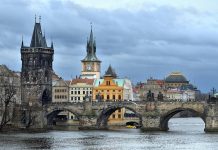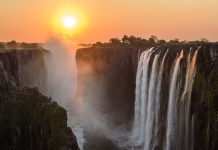Botswana is one of the few remaining destinations in Africa that still provides a good sense of the adventure of safari. Its expansive game parks and preserves, while offering wildlife as diverse and abundant as that found anywhere else, are still largely undeveloped and untamed.
Botswana lies immediately to the north of South Africa . It is bordered on the north and west by Namibia , on the north and east by Zimbabwe , and is connected by a narrow strip of land on the northern border to Zambia . Its territory consists almost entirely of a broad, flat, arid subtropical plateau, though there are hills in the eastern part of the country.
Botswana is a vast, flat dry land – as big as France but with a population of only 1.6 million, many of whom live in or near the two main cities of Gaborone and Francistown . Over 80 per cent of the country is semi-desert, but, in spite of this, abundant wildlife thrives, and with so few people, Botswana boasts the largest percentage of land given over to wildlife in the world – a remarkable 17 per cent is national park, and with the many huge private concessions in the Okavango Delta and Tuli Block, it reaches a staggering 38 per cent. All national parks and game reserves have camping areas.
In the northwest, the Okavango River empties into the Kalahari sands, creating the largest inland river delta in the world. While the Okavango Delta is home to relatively few large game animals in comparison to other areas of Botswana , its clear waters and myriad small islands are home to an astounding variety of birds, plants, and smaller species of animals.
Nearby is Chobe National Park , a beautiful grassland reserve that has gained international fame for its abundant elephant population. Southeast of Chobe are Botswana’ s enormous Makgadikgadi salt pans, home to large herds of blue wildebeest, several antelope species, and those international lovers of salt pans, flamingos.
Almost the entire remaining portion of the country is covered by the Kalahari Desert –a varied environment of sand, savanna, and grassland. Although this area of Botswana is only sparsely inhabited by humans, it is one of the richest wildlife regions in all of Africa .
Botswana’ s two largest parks, the Central Kalahari Game reserve and Gemsbok National Park , are found in this region.
Botswana’ s climate can get rather cool, particularly during the dry winter months of June-August when night occasionally brings frost. The rainy summer months (December through March) are best avoided for those interested in enjoying the best game viewing conditions.
English is the official language. Setswana is the national language, with minorities speaking Kalanga and Sekgalagadi.











